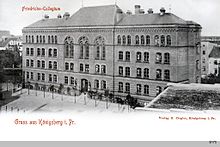Collegium Fridericianum
| Collegium Fridericianum | |
|---|---|

Collegium Fridericianum
|
|
| Location | |
|
Königsberg Germany |
|
| Information | |
| Type | Gymnasium |
| Established | 16 August 1698 |
| Closed | 1944 |
The Collegium Fridericianum, also known as the Friedrichskolleg, Friedrichskollegium, and Friedrichs-Kollegium, was a prestigious gymnasium in Königsberg, Germany. Alumni were known as Friderizianer.
Using the Francke school of Halle (Saale) as a model, Theodor Gehr (died 1705), an official of Brandenburg-Prussia, founded a Pietist private school in Sackheim on 11 August 1698. It became a royal school of Frederick I, King in Prussia, on 4 March 1701. For 16,000 guilder in 1703, it acquired the hall of Obermarschall von Creytzen on Collegiengasse in eastern Löbenicht and was designated the Collegium Fridericianum or Friedrichskolleg in honor of Frederick on 10 May. The Pietist school was the first in Königsberg not to be affiliated with a parish church. The school's first director in 1702 was Heinrich Lysius (1670-1731) of Flensburg, pastor of Löbenicht Church. The school received an organ built by Johann Josua Mosengel in 1707.
The Collegium was admired by King Frederick William I of Prussia; in a decree on 25 October 1735 the king mentioned the school as an example for other schools in Prussia. Over 50 Baltic German students went to the school before attending university in the 18th century.Immanuel Kant began attending the school in 1732, while Johann Gottfried Herder taught there from 1763 to 1764. The school consisted of a Latin school, a German school, and a boarding school often used by foreign students. It also contained a wooden tower utilized as an observatory and a small church in service until 1853.
...
Wikipedia
